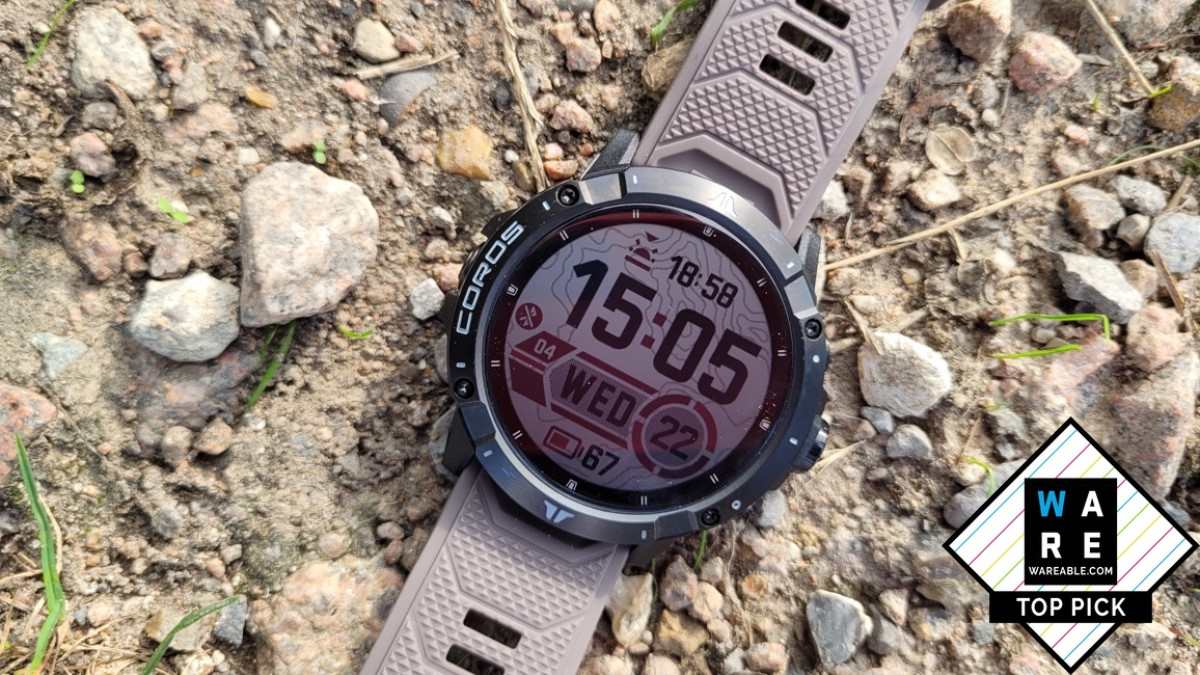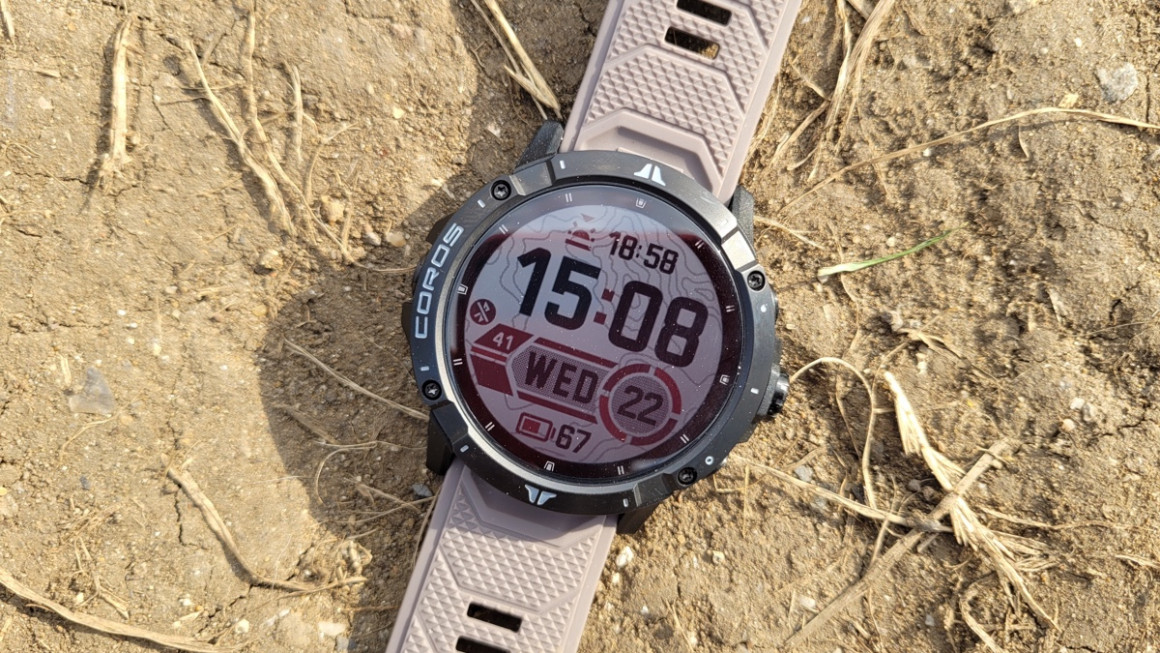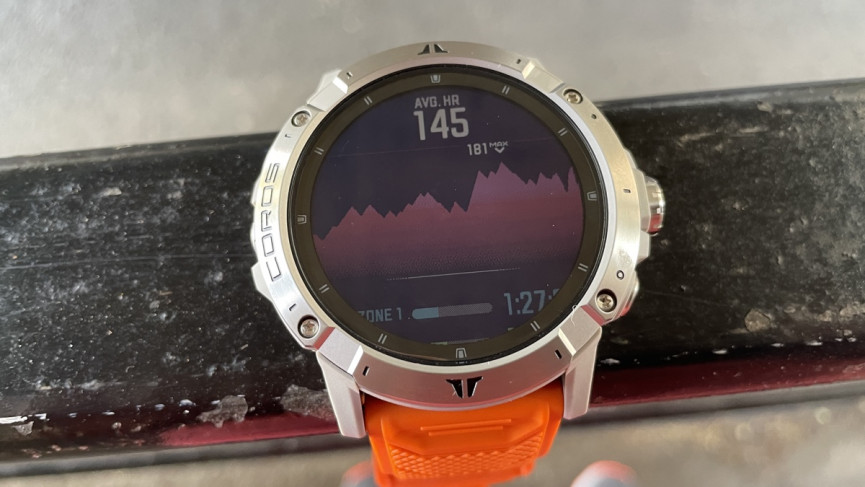
- Unrivalled battery life
- Comprehensive training insights
- Offline maps
- Good swim performance
- Bulky on the wrist
- No offline music or third party controls
- Very expensive
- Dual-GPS not a gamechanger
With an incredible 140-hour full GPS battery life – close to double the tracking time of its nearest rival – the Coros Vertix 2 has upped the staying power stakes among top-end, endurance adventure watches.
But this beast isn’t just about big battery life, Coros’ rival to the Garmin Fenix 6 also adds a dual-system GPS, mapping, music, and EvoLab – a powerful new suite of training insights to potentially rival Garmin and Polar.
Whether you tackle mountains by clambering up the side, hiking or biking the trails, this multi-tool is designed to handle the most challenging expeditions – but packs all the regular sports tracking you’d expect in a Garmin Fenix 6 rival.
It's a chunk cheaper than the Garmin Enduro – the only other watch with a battery life near the new Vertix 2. Though it still sits in the ‘considerable investment’ elite bracket of sports watches and will set you back the same as a Garmin Fenix 6 Pro.
Coros’ other recent offering, the Pace 2, offered some incredible bang for the buck. So has the sports watch challenger done it again and produced the best value adventure watch yet? Is that dual-system GPS more reliable? And does that battery life live up to the claims?
We put it to the test – including running a 4.5-hour marathon – in our Coros Vertix 2 review.
Coros Vertix 2 key specs
- 140-hour GPS battery, extends to 240 in manpower modes
- 1.4-inch, 280 x 280 64 color display
- Size: 50.3 x 50.3 x 15.7mm
- Weight: 89g
- Heart rate: Optical and ECG readings
- GPS: Full system GPS with Dual Frequency tracking
- Navigation: Offline street and TOPO maps
- Connectivity: Bluetooth 5.0, Wi-fi
- Interchangeable silicone or nylon 26mm straps
- Waterproof up to 100m
Coros Vertix 2: Battery life
Wareable
Coros Vertix 2 Battery Life headline stats:
- Smartwatch: Up to 60 days
- Full GPS: Up to 140 hours
- Max Battery GPS Mode: Up to 240 hours
- Full GPS + Music: Up to 30 hours
- All Systems GPS with Dual Frequency: 50 hours
Let’s start with Vertix’s best and most important asset – battery life. A few months back we hailed the Garmin Enduro’s 80-hour GPS battery as a game changer. And it was. But the Coros Vertix 2 takes things to the next level.
On paper, the Vertix 2 claims up to 140 hours GPS battery life and up to 240 hours in UltraMax lower power mode.
Even when you turn on the All Systems GPS with Dual Frequency to squeeze out extra accuracy, you still get 50 hours.
That beats the full GPS performance of everything but the Fenix 6X Pro (60 hours), the Enduro (80 hours), and Coros’ own Vertix 1 (60 hours).
Our battery testing results:
From a full charge, the Vertix 2 lasted 2 weeks and 5 hours, including those seven marathons – 189 miles and 30.5 hours of GPS running – with four runs in the highest accuracy, most draining All Systems + Dual Frequency Mode, all run with optical HR and one run also using music for 3 hours.
Our fastest marathon was 3:49 and the slowest was 4:39. Here’s how the battery burn rates stacked up:
Marathon 1 in Full GPS: 2% – that’d be more than COROS’ claimed 140 hours.
Marathon 2 in All Systems: 5% - that scales to around 90 hours
Marathon 3 in All Systems + Dual Frequency: 7%
Marathon 4 in UltraMax: 4%
Marathon 5 in All Systems + Dual Frequency + Music: 17%
Marathon 6 in All Systems + Dual Frequency: 9%
Marathon 7 in All Systems + Dual Frequency: 9%
Interestingly the UltraMax mode used more juice than the Full GPS though we’re not sure why.
Between runs, the Vertix 2 dropped on average 1% overnight and just 2-3% betweens runs with general use.
To put the Vertix 2’s battery life into context, if you run, ride, climb or swim for an hour a day, you’ll only need to charge this watch once a month. It’ll happily survive multi-day ultra-endurance expeditions where you’re logging day-long GPS tracking stints. The only other watch that banishes battery life anxiety like this is the Garmin Enduro.
Some very useful battery tools support that long life, including a chart of your recent usage and a prediction of how many days/hours you’ve got left across the various modes.
You can also see which functions cost the most juice. The biggest drains for us were daily heart rate and GPS. Though the backlight was the next heaviest drain. Something we found we needed to use a lot to make up for a somewhat dull display.
Coros Vertix 2: Design
Wareable
If the battery life is a big selling point for this watch, the design will divide opinions. Or at least sort the big wrists from the small.
This is a beast of a watch that’ll be too hefty for many. At 89g it’s heavier than all but the biggest Garmin Fenix 6X Pro (93g). And that bulk is noticeable. Beyond the weight, the Vertix 2 is fatter and rises higher off the wrist, making it far less comfortable than something like the Garmin Enduro, which we also found too bulky in the standard stainless steel construction. In fact, we struggled to wear it overnight.
The 26mm silicone strap doesn’t help. It’s wider, thicker, and more cumbersome than the Fenix 6, and far less comfortable than the Enduro’s nylon alternative. The quick-fit bands are interchangeable, and we’d definitely recommend one to improve wearability.
Looking beyond the bulk, this is a well-built watch with a big face-filling sapphire glass screen set inside a titanium alloy bezel and casing. It took all the knocks we threw at it in our test and durability feels on point here.
The large 280 x 280 pixel LCD colour screen displays up to eight, customizable mid-workout metrics. And there are touchscreen controls in training modes.
Wareable
In terms of colours, contrast and readability, the display looks a bit washed out. Brightness and contrast could also be better. There’s significant reflectivity in brighter light, and we found ourselves using the backlight to boost clarity. You’re trading punchy visuals to extend the battery, but heavy backlight use is also one of the biggest drains.
The watch face choices are also frustratingly limited and the few options Coros serves up are over designed and a bit cluttered. They desperately need a simpler, more minimal option.
Controls are the same two-button-plus-crown set-up that you find on all Coro's watches; easy enough to use on the move and the overall watch user interface is as simple as Polar or Garmin.
Wareable
Under the hood you get an impressive array of sensors including an optical heart rate, optical Pulse Oximeter, thermometer, compass gyroscope, and a barometric altimeter.
Like the Apple Watch and the new Fitbits, there’s also an Electrocardiogram (ECG) Sensor in the outer bezel for taking ECG and Heart Rate Variability readings. You won’t find that ECG tech on Garmin equivalents, though Coros’ tech is not yet fully approved for medical use.
One other neat design feature was a carabiner clip accessory for climbers, that locks into the watch frame to let you hang your watch securely off a pack.
Coros Vertix 2: Sports Tracking and Features
The Vertix 2 offers a comprehensive selection of sports modes including running, cycling, indoor bike, swimming (indoor and open water), mountain biking, hiking, climbing, skiing, gym cardio, GPS cardio, strength training and triathlon. With some very deep features for your more traditional pursuits.
There are also downloadable training plans and athlete-inspired sessions for running, swimming, triathlon and strength. Though frustratingly you can’t follow the sessions on the watch and the process of finding them and adding them to the app is a great deal clunkier than you’ll find on Polar and Garmin devices.
Running
Wareable
There are profiles for running, indoor running, trail running and track running. All with a very competitive array of metrics.
On top of the usual pace, distance, and real-time heart rate zone, there’s running form monitoring with stride length, cadence and running power and you can unlock additional metrics with a COROS footpod. Plus there’s a nifty metronome feature, handy if you want to work on your cadence.
To help optimise your training, there are also real-time training load and training effect estimates. We’re used to seeing these post-run but being able to measure the impact of your effort mid-session is a nice touch.
But the biggest upgrade here is EvoLab.
Wareable
A recent update to all COROS watches aside from the original Pace, EvoLab is a suite of tools and insights aimed at helping you train smarter. It brings COROS up to speed with the kind of training features we’ve seen on Garmin and Polar for a while.
The insights include real time training load, VO2 Max, pace and intensity guidance in the form of threshold pace and HR estimates, base fitness tracking, ongoing fatigue level, load impact and recovery time recommendations. It’ll also assess your running performance level and give you a marathon level for benchmarking.
This finally puts COROS on a footing with Polar and Garmin but there’s a lot of information here (the post run stats are 30 scrolls top to bottom). At times it can feel overwhelming and the distinctions, for example, between Fatigue and Load Impact are quite nuanced.
Wareable
When it comes to Running Performance, not all runs count toward your score. And that can be a little confusing.
Only completely flat runs in Run or Track Mode count, where you run for 10 minutes or more, and your heart rate hits at least 70% of your max. So if you train on hills and trails this feature becomes a bit meaningless.
Recovery time was more aggressive than the Garmin, with a tendency to have us bouncing back quicker from most workouts.
For example, the morning after a marathon run test, the Vertix 2 suggested 31 hours until full recovery while the Garmin was double that.
In terms of VO2 Max, the Vertix put ours at 52 versus the Garmin Enduro’s 54. This makes it more odd that the Coros race time predictor tool was considerably more optimistic than Garmin’s, predicting a 20 minute faster marathon, a six-minute faster half, a one-minute quicker 10km but oddly a 10-second slower 5km. Based on current fitness, Garmin’s feel more accurate.
Swimming
Wareable
The Vertix 2’s pool and open water swim smarts are comprehensive. It tracks all the important lengths, distances, average pace, stroke count and rate. Plus there’s automatic stroke detection, SWOLF swim score, and underwater wrist-based heart rate.
Accuracy in the pool was good. Over a 1300m session in a 25m pool, it clocked one length less than the Form Swim goggles.
By contrast the Garmin Enduro over-clocked the same swim by 200m. Stroke detection was excellent, though SWOLF scoring was much harsher than the Garmin Enduro and FORM goggles consensus.
It will also track heart rate from the wrist and feed that data into a Training Effect and Training Load reading. Up against the Enduro, it tended to read low across average and max heart rates.
Coros Vertix 2: Health tracking
Wareable
Outside of workouts, the Vertix 2 also monitors daily activity, sleep, resting heart rate, and stress. You can also use the ECG to take heart rate variability (HRV) readings.
Unlike Garmin, there’s no hydration and menstrual cycle tracking.
Sleep tracking is fairly detailed, with light and deep but not REM sleep stages tracking. Although we found the Vertix 2 too bulky to wear in bed. Against an Oura Ring, Withings Sleep Mat and Garmin Enduro, the Vertix 2 was pretty solid at picking up drop-off and waking times but tended to overestimate deep sleep.
Coros Vertix 2: Heart rate accuracy
Wareable
We put the Vertix 2 through a range of tests up against a Polar H10 chest strap and the Enduro’s optical sensor, including an interval session, a slow hour-long effort and a marathon run test.
Like all optical sensors, the Vertix 2 had some lag and lurch, particularly on the intervals.
Average workout readings came within a beat or two of the chest strap but it had a tendency to clock a higher max heart rate.
Overall, pretty standard fare for wrist-based heart rate and we’d recommend a chest strap to improve the accuracy of your training data.
Resting heart rate felt reliable, matching the Garmin Enduro for highs, lows and averages.
Wareable
You can also broadcast heart rate via Bluetooth to third-party devices.
At the heart of the new Coros is a dual-frequency GPS chipset. That may not sound very sexy, but it promises better GPS coverage, especially in built-up urban spaces, where there’s tree cover or in deep valleys. That should mean better accuracy, and improved pinning of your position on maps.
This hardware change brings three GPS modes: Standard GPS only (default), All Systems On, and All Systems + Dual FREQ On.
Firing up the all-guns GPS does cost battery life, and in our tests running and riding the city and mountain trails, up against a Garmin Enduro and Fenix 6 Pro, in reality we found the difference wasn’t marginal. Real-time pacing wasn’t hugely improved and the maps still showed us running through buildings like all GPS watches.
It’s not something we’d recommend buying this watch for, and in truth, we didn’t find the battery life trade off worth it either.
In full GPS mode, the Vertix 2 matched the Enduro and the Fenix 6 Pro. All of our runs, rides, and hikes were within the normal margin of error in terms of accuracy.
When it came to logging elevation on climbs and descents in the mountains, the Coros tended to clock lower than the Garmin Enduro but no more than 5%.
COROS Vertix 2: Navigation Features
Wareable
In terms of navigation, the Vertix 2 is a big step up from the Vertix. It’s now one of the few outdoor watches with mapping support, offering three-layer maps with the global offline landscape, TOPO to download for free and a hybrid option.
Though somewhat strangely there’s no turn-by-turn direction feature, and that’ll be a big miss for some. You only get deviation alerts if you wander off your pre-loaded route.
Adding routes is fairly easy – at least those you’ve run already. You can scroll through past activities, download, and send to the watch in a few taps. You can store up to 10 routes on watch.
Selecting a route is also nice and easy and the course elevation profile graphics and details of elevation gain/loss are a nice touch before you run, ride or hike.
One other criticism we have here is that slightly washed-out screen, which makes it quite hard to see the maps on the move.
COROS Vertix 2: Connectivity
The Vertix 2 supports Bluetooth 5.0 Dual Mode and Wi-Fi, so it’ll play nice with a wide selection of chest straps, accessories, and third-party devices, including broadcasting heart rate but there’s no ANT+ compatibility.
We also had occasional issues with syncing the watch with the app. More than once we had to go through the process of uninstalling the app, clearing past Bluetooth pairings, and reconnecting the watch.
COROS Vertix 2: Music & Smartwatch Skills
Wareable
Coros is still playing catch-up when it comes to smartwatch bells and whistles like contactless payments and calls. The Vertix 2’s skills are largely limited to customisable smartphone notifications.
But one new addition is offline music storage and playback direct to paired headphones, with up to 32 GB of storage for MP3s. Pairing headphones was straight forward. Loading music onto the watch is less so.
You have to plug your Vertix 2 into your laptop and drag and drop tracks and podcasts across like it’s 2003.
There’s no way to order your tunes either, it’s just one big pot of tracks. And you get none of the more seamless streaming support for Spotify that Garmin offers. Nor Amazon Music, Apple Music. And there are no controls for music you’re playing via those services even if you are carrying your phone.
Weather-wise you get temperature, air pressure, sunrise and sunset times, and storm alerts. Though you won’t get weather predictions as you do on the Garmin Fenix 6.
If you like to shoot your adventures and you own a compatible Insta360 action camera (Insta360 Go 2, One X2, and One R), you can also control that from the watch.
How we test
